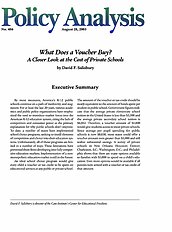An ideal school choice program would give every child a voucher or tax credit to be spent on educational services at any public or private school. The amount of the voucher or tax credit should be nearly equivalent to the amount of funds spent per student in public school. Government figures indicate that the average private elementary school tuition in the United States is less than $3,500 and the average private secondary school tuition is $6,052. Therefore, a voucher amount of $5,000 would give students access to most private schools. Since average per pupil spending for public schools is now $8,830, most states could offer a voucher amount even greater than $5,000 and still realize substantial savings. A survey of private schools in New Orleans; Houston; Denver; Charleston, S.C.; Washington, D.C.; and Philadelphia shows that there are many options available to families with $5,000 to spend on a child’s education. Even more options would be available if all parents were armed with a voucher or tax credit of that amount.
What Does a Voucher Buy? A Closer Look at the Cost of Private Schools
By most measures, America’s K‑12 public schools continue on a path of mediocrity and stagnation. For at least the last 20 years, various academics and public policy organizations have emphasized the need to introduce market forces into the American K‑12 education system, citing the lack of competition and consumer power as the primary explanation for why public schools don’t improve. To date, a number of states have implemented school choice programs, seeking to instill elements of competition and choice into their education systems. Unfortunately, all of those programs are limited in a number of ways. These limitations have prevented them from developing into fully competitive education markets. Implementation of a non-monopolistic education market is still in the future.

This work is licensed under a Creative Commons Attribution-NonCommercial-ShareAlike 4.0 International License.
